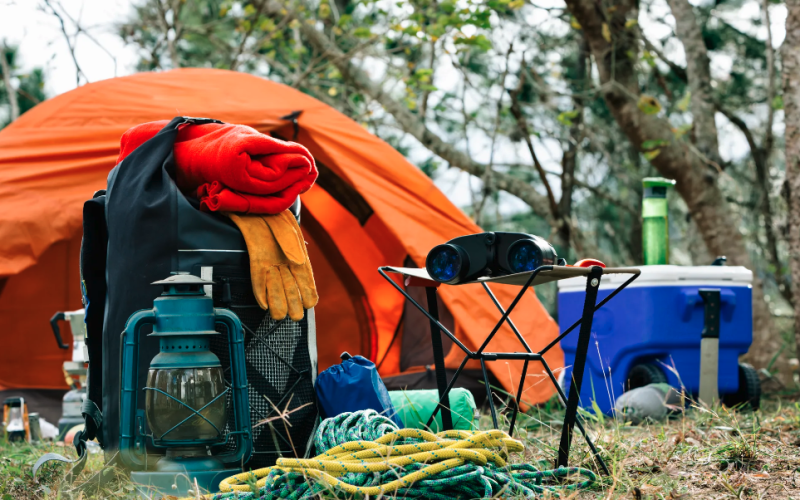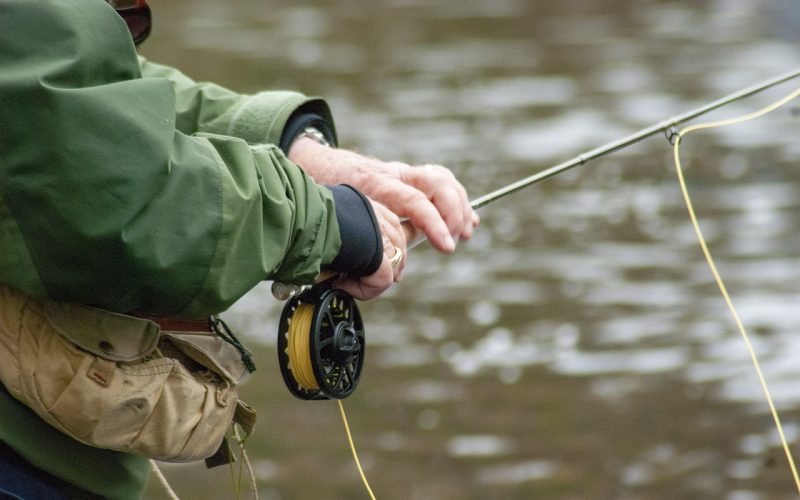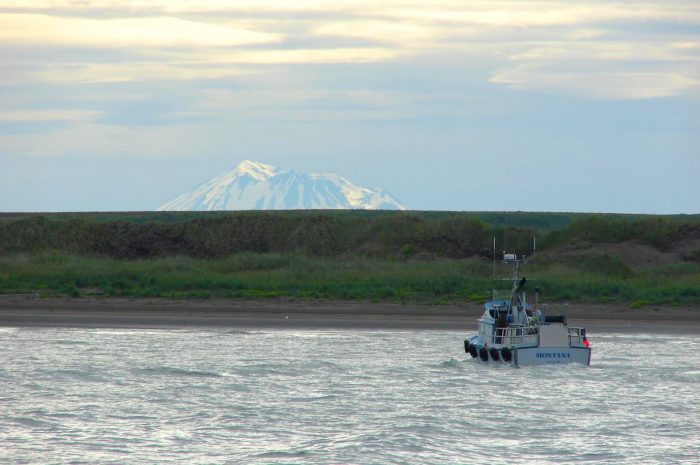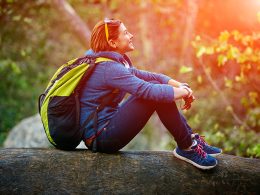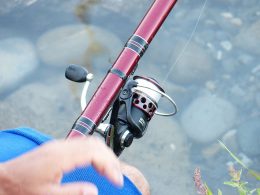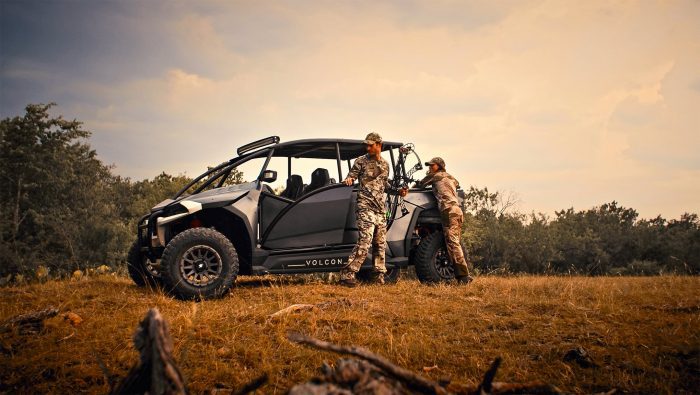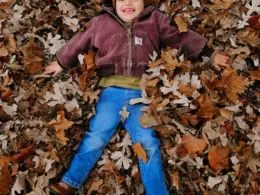Experiencing the great outdoors is a passion for many and a mystery to others. Enjoying mother nature isn’t difficult, but if you’ve never done it before then it can seem daunting to prepare for.
The reality of the situation is that you can easily go camping with as little gear (or as much) as you want. The question is where do you start? Well, the answer depends on how willing you are to give up the comforts of home for a good camping experience.
This guide is for both experienced campers and newcomers. It’s going to help you keep the gear list organized so that you don’t forget anything. It includes some additional tips to ensure that you have a successful camping experience.
Table of Contents
What Kind of Camping Are You Doing?
Before you begin perusing the plethora of camping gear websites, before you think about what you need, you should figure out what kind of camping you’re going to do.
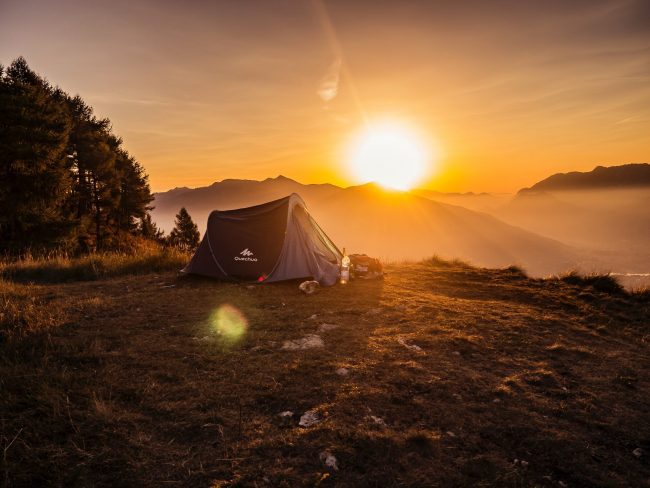
The Car Camper/Glamping
This style of camping is what most people begin with and what they are most comfortable with. Car camping excursions are those childhood trips with your family that involve a drive-up campsite in a park or private campground.
The unique thing about this style of camping is that it’s so easy to get into and is often the gatekeeper for other more involved trips. You have the basic amenities available to you such as power, running water, and even bathrooms. The idea is to explore nature without sacrificing most of the comforts of home.
Even though car camping is primarily done in the warmer months, it still requires a large amount of gear. If you’re just getting into camping this is the best way to ease yourself into it.
The Backcountry Tripper
Backcountry camping is a little more involved than the glamping experience. Here you have no running water, power, or basic amenities, meaning you have to provide it yourself. This style of camping requires more planning and organization as forgetting an item can cause the trip to end prematurely.
Most popular backcountry trips involve canoeing through various lakes, completing portages, and setting up your campsite. Others include hiking to a remote destination while also setting up camp. You get the general idea: you’re in charge of every aspect of the trip.
Gear requirements for this type of trip tend to be a little more expensive than with glamping. This is mainly due to the quality of the gear that you will be bringing with you. Where you might get away with cheaper gear on a more basic trip, you want reliable, reputable gear that is going to not break down for backcountry trips.
The Minimalist/Survivalist
Ultralight camping trips are usually defined as having a base weight that is 10 pounds or less. This means that you either have limited gear or you are planning on doing some bushcraft to build a shelter, chair, and other comfort objects for the duration of your trip.
This type of camping is reserved for those that are comfortable being outdoors and know how to take care of themselves. Some may consider this the pinnacle of camping since you are relying a lot on the environment around you for a successful trip.
There is no shame in admitting that this style of camping may not be accessible to you since it’s pretty much only done by people who enjoy a certain level of mental and physical pain. This is mainly due to the possibility of having some uncomfortable nights of being poorly unprepared, but to those who enjoy it, it’s just part of the experience.
The reward, however, is an unforgettable experience knowing that you can survive on your own in the wilderness without having to rely on modern amenities. Also, it’s quite a bit cheaper than the other styles of camping, making it an excellent choice for those who are brave, and on a budget.
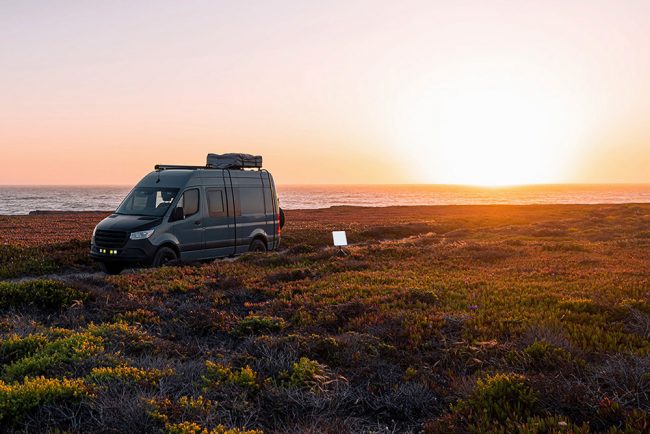
Stay Within Your Comfort Zone
While you now know the main “styles” of camping, it’s wise to understand that you don’t need to try them all out. Camping is all about exploring nature in the capacity that you want, not what you think you can handle.
The truth is, all types of camping present a potential risk to your safety. The other thing is that you don’t need to break the bank when it comes to camping. Stay within budget and borrow the necessary gear if that’s what it takes.
Divide the Gear List into Sections
The gear list for your trip can be as small or as exhaustive as you like. The easiest way to organize yourself is to divide the gear list into different categories. This will simplify the packing process as you won’t have random items mixed with other items.
Not only will this help you identify what you need from each section but also keeps the list nice and clean for easy readability. As you may discover on your own, a messy list can cause you to forget stuff for your trip.
The next section of this guide is broken down into those systems so that you can easily identify what falls into each category. While the list isn’t exhaustive, it will give you an idea of what you should bring with you.
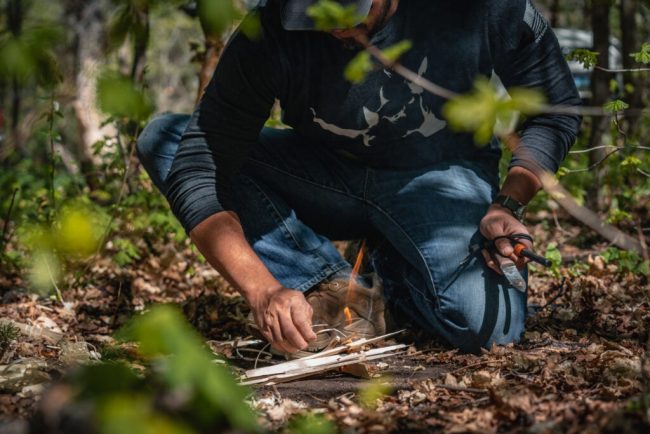
Fire Starting
Starting a fire not only brings comfort and warmth to your site. It might be your only source of water purification and cooking if you forget a stove or water. You must bring multiple methods of starting a fire in case your initial method fails. Most people may bring a simple lighter to try and start their fire, but as soon as it gets wet it won’t light at all.
Here is a list of items to start a fire that you can bring with you on your next camping trip:
- Ferro Rod
- Magnesium bar with strikers
- Waterproof matches
- Flint and steel
- Lighters
Additionally, you should also pack some firestarters in case you can’t find tinder out where you’re camping. This can include items such as:
- Hexamine tablets
- Duct tape
- Birch bark
- Char cloth
- Cotton balls and Vaseline
- Fatwood
Creating your fire kit with these items will make it an easier process. Some people store their fire-starting equipment in a simple ziploc bag for easy process while others use elaborate carrying devices such as leather sacs or nylon pouches
Water Purification
Aside from bringing your own bottles of water, having the ability to filter more is essential for anything beyond car camping. There are a ton of products on the market and knowing which is best depends on the season that you’re camping in.
For example, using a membrane filter in the winter is dangerous since the water inside the filter itself can freeze and expand, rendering the filter unusable. For those months, boiling the water is generally the best way to purify it.
If you forget your water purification gear then boiling your water is still a viable solution in most situations (it doesn’t work if the water is contaminated with chemicals). As long as you have a metal container and a fire, you can boil water for drinking.
Here are the best types of water purification products you can bring with you on camping trips:
- Membrane filters (Lifestraw, Sawyer Squeeze, gravity filters)
- Chemical tablets (chlorine)
- Iodine and Vitamin C tablet combination
- UVC light
As with the fire-starting category, it’s important to bring multiple ways to purify water. This can be in the form of a membrane filter, chemical tablets, and then boiling as your last resort if those fail.
Shelter
If you don’t plan on building your shelter then you’ll most likely be packing it with you. There are a lot of choices when it comes to the kind of shelter you can use but for the sake of this article, we will stick to the simple tent and hammock shelters.
Tent Camping
For most people, a tent with a rainfly will suffice as a shelter for their trips. Look for reputable brands such as Eureka, MSR, Big Agnes, and The North Face as they generally have higher-quality materials and construction.
Depending on the season you’ll want to pick your tent carefully. Luckily, tents are broken down into seasons with the majority of them being “3-season” tents. Look for a 4-season tent if you plan on using it in the winter as they typically have features that help keep the heat in.
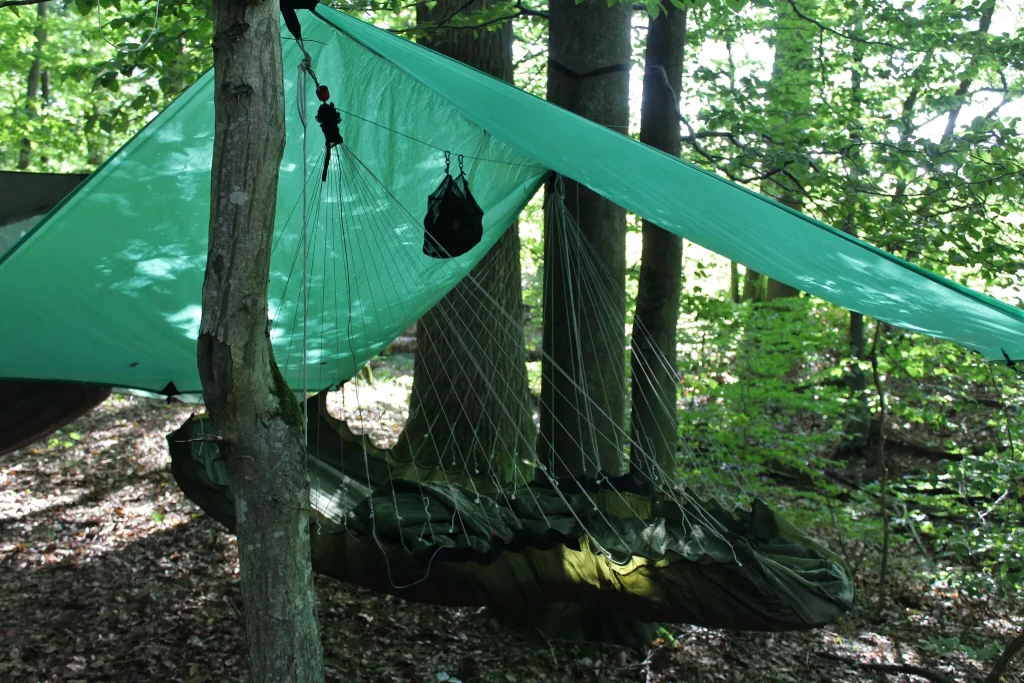
Hammock Camping
If you plan on using a hammock for camping then make sure you have all of the right accessories to go with it. This is largely due to a hammock having specific considerations that you won’t need in a tent.
For example, a hammock needs a tarp to help ward off rain, a bug net to prevent mosquitos and other biting insects from snacking on you, and an under quilt that will help keep the heat from your body being whisked away underneath you.
Popular hammock companies such as Hennesey, Warbonnet, and Eno make some incredible hammock products that you can use for your next camping trip.
Sleep System
A sleep system consists of a sleeping pad, a sleeping bag (or quilt), and a pillow. The combination of these items will determine whether or not you have a restful sleep or a night of tossing and turning.
Out of all of the sections, this one is near the top in regards to importance as you will be spending several hours in our shelter trying to catch some shuteye.
Sleeping Bag
Sleeping bags are rated by the temperatures that they can handle. You’ll generally see three temperatures associated with the bag, that is the comfort rating, the limit rating, and the extreme rating (how low it goes before your life is in danger).
The important thing to remember is that manufacturers usually make those ratings based on perfect conditions, and as such, they can be widely inaccurate with what they can handle. When in doubt, always go with a colder rating to ensure you don’t get cold.
Sleeping Pad
Sleeping bags come in two main types, closed-cell foam, and inflatable pads. During the warmer months, you can use an air pad for comfort, but in the wintertime, it’ll be best to use a combination of a closed-cell foam pad and an air pad to maximize the insulation value.
Clothing
You don’t need to go out and buy any technical clothing to enjoy camping but there are some considerations to make before you include your closet. As with any outdoor situation, bring extra pairs of thighs in case they get wet or damaged during your trip.
- Avoid too much cotton clothing during hot weather because it isn’t breathable, meaning if you sweat through the material it will stay wet.
- Bring some form of waterproof outer clothing such as a raincoat and pants in case it rains
- Wool is excellent for cold weather since it will keep you warm while wet
- Bring light-colored clothing in hot, sunny weather so it doesn’t absorb light. Additionally, insects like ticks enjoy darker clothing
- Speaking of ticks, bring long-sleeved shorts and pants, even when sunny. It’ll protect you from the sun and the biting bugs.
That being said, for car camping trips you can pretty much bring whatever you have in your closet since you’ll be close to your vehicle and other amenities. It’s the backcountry trips that require a little more planning to optimize the clothing loadout you’ll be using.
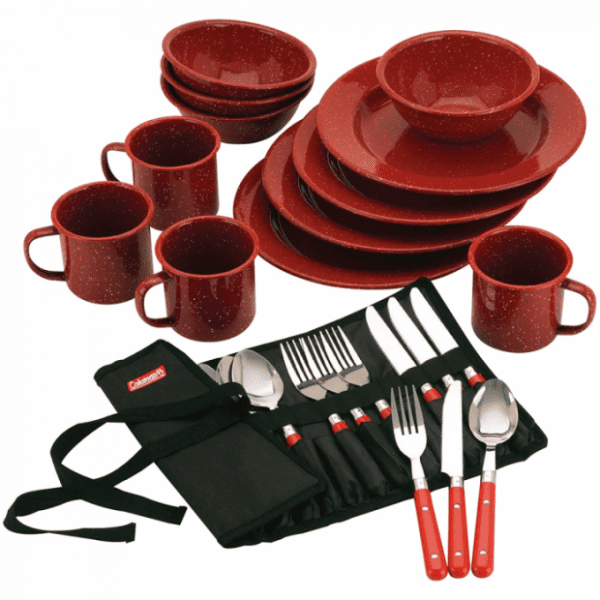
Cooking Gear
The cooking gear you bring will determine what kinds of meals you can make while camping. Most people will bring a propane or butane stove just so they have an on-demand cooking appliance to help them make meals. Others prefer to be more rugged and use a fire to help them cook.
Here is a list of items you will want to bring with you for cooking on your camping trip:
- Cooking pot (soups, stews, boiling water)
- Frying pan
- Plate and bowl
- Utensils for eating (fork, knife, spoon)
- A cup for drinking
- Recipe-specific items (for example, a measuring cup for baking)
Whatever cooking equipment you bring depends on what you want to cook while you’re out camping. As with the other items, lay out the recipe plan and what gear you’ll need to make it beforehand so that you don’t forget anything.
Safety/Medical Equipment
Being safe while camping should be at the forefront of your mind at all times. As the saying goes, it’s all fun and games until someone gets hurt. Luckily, a lot of the gear meant to keep you safe is easily packable and even easier to use. A lot of these items can even be used for multiple tasks, providing a lot of utility.
Here are some of the safety items you can bring with you on your next trip:
- Small first-aid kit
- Knife/Axe/Saw
- Headlamp
- Bear Spray
- Whistle
- Map/compass
- GPS unit
This list is not exhaustive by any means but it’ll give you a decent kit to deal with any minor problems. It’s advisable to learn more about wild medicinal plants to supplement your medical kit. Additionally, learning about the wildlife in the area can prepare you for dealing with any chance encounters on your trip.
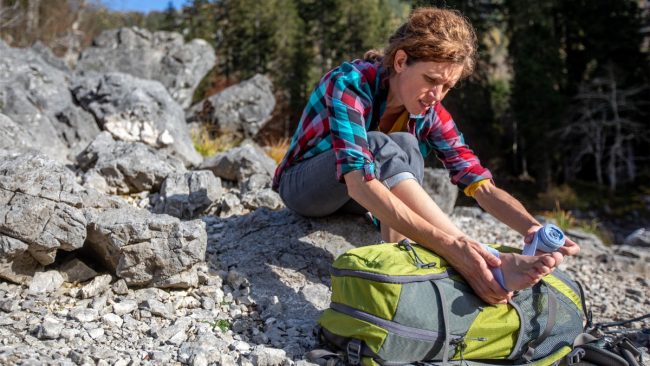
Final Thoughts
Camping is primarily a learning experience as you figure out what gear you need and what you can ultimately leave behind. Categorizing the type of gear helps you stay organized and ensures you don’t forget anything.
Most importantly you want to have fun while camping, even if you do end up forgetting something. In most cases, not bringing one or two items won’t spell disaster and you might even find you didn’t need them to begin with.

